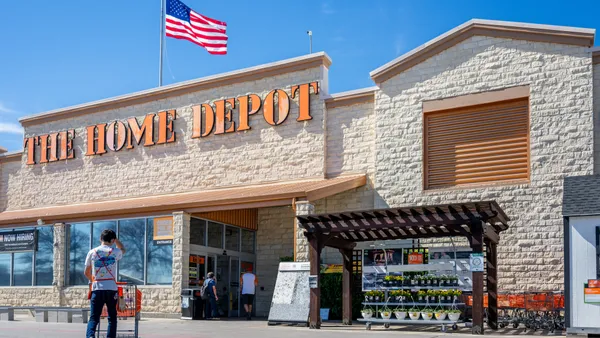Dive Brief:
- GameStop on Monday reported total sales fell 13.3% year-over-year to $1.5 billion as consolidated comparable sales fell 10.3%. Driving the sales declines were drop-offs in most of the gaming retailer's key categories.
- New hardware sales were down 35%, pre-owned sales were down 20.3%, new software sales were down 4.3% and digital receipts were down 6.7%. The only categories on the rise were accessory sales (up 0.6%) and collectibles (up 10.5%), the latter a high-margin business and one of few bright spots. At $7.5 million, net income was down more than 60% from the year-ago period.
- Last week, GameStop announced it created new chief customer officer and chief merchandising officer roles to help with its turnaround efforts. Filling the chief customer officer slot is Frank Hamlin, previously chief marketing officer for Tailored Brands. GameStop also brought in Chris Homeister, former CEO of The Tile Shop, as chief merchandising officer, and James Bell, former chief financial officer of Wok Holdings, as the gaming retailer's new CFO.
Dive Insight:
As the gaming world moves toward streaming, GameStop is under pressure to transform itself and its nearly 5,800 stores. As Jeffries analysts led by Stephanie Wissink said in a client note emailed to Retail Dive, "patience is thin" among investors, and so what comes next "needs to be big."
To shore up its balance sheet and add flexibility, the retailer nixed its quarterly dividend to shareholders. The move should save some $157 million in cash annually as GameStop looks to invest in its business. For 2019, management said they expect to make up to $110 million in capital expenditures. And the stakes are high for those to pay off, as the company also anticipates comps to fall between 5% and 10% this year.
The Jeffries analysts noted lags in assessment, plan development and execution at GameStop as it tries to head off sales and profit declines. "[I]n our view, GME now faces the need for a dramatic pivot, wholesale changes, and aggressive action to remain relevant."
The company recently brought in a new CEO, George Sherman, who acknowledged in his first call with analysts Monday that "we need to transform to remain a viable player in our industry, which is currently undergoing meaningful technological change," according to a Seeking Alpha transcript. Right now the company is reviewing its costs and operating performance in search of $100 million in operating profit improvements.
Sherman also said he saw opportunities in collectibles, pricing and space allocation at the company's stores, where 20% of SKUs drive 80% of the business. GameStop is also testing experiential elements that focus on key merchandise categories "immersive interactive experiences and pop culture."
For now, the company's balance sheet isn't a problem. It carries less than $500 million in long-term debt on its books and is still posting positive income. But as Wissink and her team noted, "viability" could quickly become a concern if the retailer's income keeps falling.
Axing the dividend buys more than a year if profits fall at the same rate, but the retailer also needs "significant real estate remediation, reframing of the model, and asset leverage" to stabilize, the analysts said, noting that the pace of change is the key risk.













